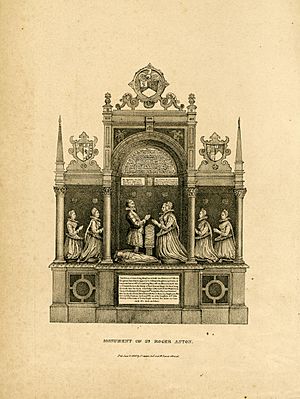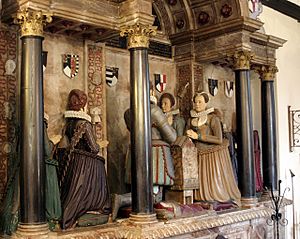Roger Aston facts for kids
Sir Roger Aston (died 23 May 1612) was an English courtier who became a trusted friend of James VI of Scotland. He lived in Cranford, Middlesex, England.
Contents
Early Life and Career
Roger Aston started his career by working for important Scottish figures like the Earl of Lennox, Lord Darnley, and Mary, Queen of Scots. In 1578, he became a Gentleman of the Bedchamber for James VI of Scotland. This meant he was a close personal attendant to the King.
Later, when James VI also became King James I of England, Aston was made the Master of the Great Wardrobe in England. This important job involved managing the King's clothes, fabrics, and other household items. He held both these positions until he passed away. From 1595, he was also in charge of Linlithgow Palace in Scotland.
Life at the Scottish Royal Court

In May 1580, Roger Aston was one of 25 gentlemen chosen to always be with King James VI when he rode out. This group included other important people like Captain James Stewart and Walter Stewart of Blantyre.
In July 1582, Aston went to Antwerp with a Scottish diplomat to bring back Colonel William Stewart. Aston wrote to the Earl of Leicester, an English nobleman, about his mission and what was happening in Scotland.
An important event happened in 1583. King James VI had given a ring to an English official, Francis Walsingham. But Walsingham found out the stone in the ring was not valuable. He gave the ring to Aston to return to Scotland, but Aston later said it was stolen from him.
Helping with Important News
In September 1586, Aston delivered King James's congratulations to Queen Elizabeth I of England. This was after she discovered the Babington Plot, a plan against her. In December 1586, he rode to London again with other Scottish ambassadors. They were sent to ask Queen Elizabeth to spare the life of Mary, Queen of Scots. Aston also received £4,000 from Queen Elizabeth for King James, which was part of a regular payment.
Aston was the one who brought the sad news of Mary, Queen of Scots' death to King James VI in February 1587. Some people thought this news might make King James less fond of Aston, but Aston's good reputation did not suffer.
Court Life and Travel
In July 1587, Aston wrote from Falkland Palace about how he felt left out and wanted to find new opportunities. He also wrote about his hopes for Queen Elizabeth to support King James. At one point, it was thought that Aston and another courtier, Sir William Keith, might lose their jobs because they had supported someone who was no longer in favor with the King. Some people even called Aston and his friends "Queen Elizabeth's pensioners" because of their ties to England. Aston felt he was watched because he was English and couldn't write as often as he wished.
In 1588, Aston was robbed of £70 in gold and some jewels while he was sleeping in Edinburgh. Despite this, he remained in the King's service. In December 1588, he stayed at Kinneil House and played a card game with the King. Aston wrote that King James was happy to hear about the deaths of Catherine de' Medici and the Duke of Guise, two important French figures. He also mentioned that he was getting tired of how uncertain things were in Scotland.
In August 1589, Aston traveled to London to buy things for the arrival, wedding, and crowning of Anne of Denmark, who was marrying King James. He also tried to arrange for actors from England to perform in Edinburgh. However, bad weather stopped Anne of Denmark from sailing to Scotland. Aston then traveled with King James to Norway and Denmark in 1589 and 1590 to meet Anne.
Later, in 1592, King James VI sent Aston to Queen Elizabeth to explain that a rebel, Francis Stewart, had broken into Holyrood Palace. He also asked for an early payment of the English money to help pay for a royal guard. When Aston returned, he tried to convince Queen Anne not to help those who supported the rebel.
The Keeper of Linlithgow Palace
Aston became the keeper of Linlithgow Palace. He once played a joke by hanging a copy of his family tree next to the King of France's family tree in the palace gallery. King James VI found this very funny! In 1594, Aston helped repair the roof of Linlithgow Palace using lead from England. In 1595, he sold a horse to King James for £200 Scots. He also asked the English ambassador for a large portrait of Queen Elizabeth. The ambassador called him the "good captain of Lithgow."
Aston often wrote letters to Sir Robert Cecil, an important English official. These letters were very private, and once, when they were stopped and sent back to Scotland, Aston was at risk of getting into trouble. It is likely that King James knew what Aston was sharing with his English friends and found it a helpful way to get information.
Aston and Queen Anne
Aston's wife, Mary Stewart, was a lady-in-waiting in Queen Anne's household. In 1598, Aston hoped to buy land in Scotland for his family, but he faced financial problems because of a banking crisis.
He also kept Sir Robert Cecil informed about the Queen's disagreements within the court. These arguments were mostly about who would take care of her son, Henry Frederick, Prince of Wales.
Aston suspected that Queen Anne might have been involved with the Ruthven brothers and the strange events that led to their deaths at Gowrie House. He wrote about these suspicions to Cecil, saying there was strong evidence from letters and other clues.
In January 1601/2, Aston went to London to collect money. He also delivered gifts from the wife of a diplomat to Queen Anne.
In March 1602, Aston was hurt in a fall at Dunfermline Palace and was unconscious for three hours. After he recovered, he talked with Queen Anne about how her support for the exiled Ruthven family might have damaged her reputation in England.
Life in England
After Queen Elizabeth died and King James became King of both Scotland and England, Aston traveled to York in April 1603. He told Lord Burghley that King James would stay at the King's Manor for Easter on his way to London. Aston was knighted on his journey south. In October 1603, King James gave Aston's Scottish pension to someone else. In November 1603, Aston and another Scottish courtier brought news of an important trial to the King.
King James sometimes joked about Aston, especially about him being from Cheshire. In 1605, King James sent a manuscript he had written to the Earl of Salisbury. He joked that the language in the manuscript was difficult to understand, like the Welsh spoken by Aston, even though Aston was from Cheshire.
As Master of the Wardrobe, Aston was involved in decorating the seating in the Houses of Parliament in 1608. In 1610, he was in charge of a small park at Eltham Palace and built four bridges there for King James's convenience.
He was also a Member of Parliament for Cheshire from 1604 to 1611.
King James honored Sir Roger by adding a special symbol to his family crest. This symbol combined the rose of England and the thistle of Scotland, showing the union of the two countries. This was done because Sir Roger married Mary Stewart, a lady-in-waiting to Queen Anne and a relative of the King.
A writer named Godfrey Goodman said that Aston was "a very honest, plain-dealing man, no dissembler, neither did he any ill office to any man." This means he was a straightforward and good person who didn't cause trouble for others.
Sir Roger Aston is buried in St Dunstan's Church, Cranford, London, in a beautiful church monument.
Family Life
Roger Aston first married Mary Stewart (who died on April 11, 1606). She was a lady-in-waiting to Anne of Denmark and related to the King. They had four daughters:
- Margaret, who married Sir Gilbert Houghton.
- Mary, who married Sir Samuel Peyton.
- Elizabeth, who married Sir Robert Wingfield.
- Anne, who married Sir Thomas Perient.
Anne Aston was almost married to a very important nobleman, George Villiers, but a Scottish gentleman advised him not to.
Roger Aston's second wife was Cordelia Stanhope. They had one son who sadly died when he was a baby.


